FDSA Overview

The FDSA is a feed delivery planning tool that provides a complete and
efficient delivery plan based on the parameters established by the customer.
The process uses feed consumption tables and feeding programs to determine
the feed deliveries.
The FDSA Overview document contains the following components that are
required prior to set-up:
Setup
The purpose of the setup overview is to review some of the switches
required for FDSA. It is not required to establish every switch during
the pre-implementation session, however careful consideration is required
before implementation.
General
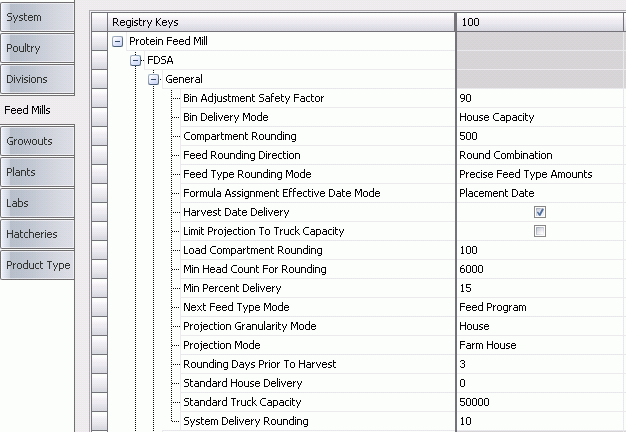
- Bin Adjustment
Safety Factor – modifies the bin capacity used for feed delivery
to reduce the chance that too much feed will be delivered. The factor
is entered in percentage so that a value of 80 will project deliveries
at 80% of the bin capacity.
- Bin Delivery
Mode – if there are multiple bins, this option determines how
the feed is delivered to the bin.
Always Alternate – FDSA projects deliveries
alternating between bins. Example, Bin A, Bin B, Bin A, Bin B.
First Bin Except First Delivery – will
always project to Bin A except for first delivery. First delivery
has the option to project to the empty bin.
House Capacity – will project to use
all bins on the house. Only one feed type per bin.
House Capacity Mix Feeds - will project
to use all bins on the house. Multiple feed types per bin.
House Even Bin Ending Inventory – FDSA
projects to balance all ending inventories in the bins. Multiple
feed types per bin.
- Compartment Rounding
– rounds deliveries to the nearest value entered in this field. Example,
3,000 will round the delivery to the nearest 3,000 lbs or kgs.
- Feed Rounding
Direction – determines how the feed deliveries are rounded.
Round Up – always rounds up. Example,
1.4 rounds up to 2.0
Round Down – always rounds down. Example,
1.4 rounds down to 1.0
Round Combination – rounds down or up.
Example, 1.4 rounds down to 1.0 and 1.5 rounds up to 2.0.
- Feed Type Rounding
Mode – if a load is comprised of multiple formulas, the switch
determines how the feed is rounded. For example, a load of 12,000lbs
has 3,000 Starter and 9,000 Grower.
Precise Feed Type Amounts – projects
3,000 Starter and 9,000 Grower
Advance to Next Feed Type – projects
12,000 Grower
Extend Previous Type – projects 12,000
Starter
- Formula Assignment
Effective Date Mode – links the effective date of the formula
assignment to the entity based on either Placement Date or Projection
Date.
- Harvest Date
Delivery – if selected, FDSA will project feed on harvest date.
- Limit Projection
to Truck Capacity – limits the projected delivery amount to
a single truck.
- Load Compartment
Rounding – factor to round loads for delivery. Example, 1,000
will round load to nearest 1,000 lbs or kgs.
- Min Head Count
for Rounding - minimum head count before projection applies
any amount of rounding
- Min Percent Delivery
– factor used to determine minimum percentage of compartment that
can be delivered.
- Next Feed Type
Mode – determines how the projection transitions to the next
feed type.
- Projection Granularity
Mode – determines if deliveries are projected by entity, house
or pen.
- Projection Mode
– specifies the flock number format for the lowest granularity that
is delivered. Options are:
Farm – projects all of the houses on
a farm in a single unit. Each house is analyzed but only a single
projection for the farm.
Farm House – projects based on a single
delivery date for all houses prioritizing houses based on the
lowest to highest days to empty.
House Independent – projects based on
different delivery dates for houses prioritizing houses based
on the lowest to highest days to empty.
- Rounding Days
Prior to Harvest – represents the number of days prior to harvest
that compartment rounding will be ignored.
- Standard House
Delivery – standard house amount used to project delivery.
The value will not overwrite bin capacity.
- Standard Truck
Capacity – maximum standard truck capacity used for projections.
- System Delivery
Rounding – rounding factor used when no compartment rounding
or feed type roundings are defined. Factor is entered in percentage.
BIM
These Registry settings are used in FDSA>Projections>BIM
for projection purposes.
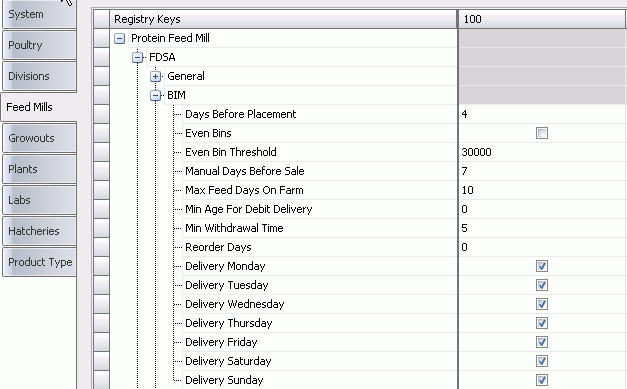
- Days Before Placement
– number of days before placement that feed delivery is scheduled.
- Even Bins
– option is used when Projection Mode is set to Farm House. Selecting
this option will project deliveries to the houses so that the
bins will be empty on the same day.
- Even Bin Threshold
– limits the even bin option to farms that have house head capacities
less than the threshold.
- Manual Days Before
Sale – number of days prior to slaughter that deliveries are
defined as manual deliveries. Entities will remain in projection but
identified as a manual delivery.
- Max Feed Days
on Farm – represents the maximum number of days that the feed
can be stored at the farm.
- Min Age for Debit
Delivery – determines the age that feed transferred into the
entity from another entity can be used in the projection. For example,
if withdrawal feed is transferred into the entity, the number of days
from placement date that the withdrawal feed can be used.
- Min Withdrawal
Time – minimum number of days prior to slaughter that withdrawal
feed is required.
- Reorder Days
– FDSA projects to deliver feed when the number of days to empty is
zero. If more lead time is required, enter the number of lead days.
For example, if a value of ‘1’ is entered, the projection will occur
when there is one day to empty.
- Delivery Sunday-Saturday
– select the days of the week that feed can be projected to be delivered.
BRIM
These Registry settings are used in FDSA
>Projections>BRIM for projection purposes.
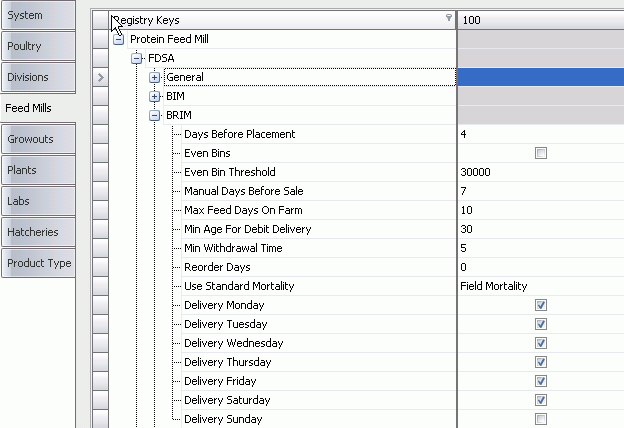
- Days Before Placement
– number of days before placement that feed delivery is scheduled.
- Even Bins
– option is used when Projection Mode is set to Farm House. Selecting
this option will project deliveries to the houses so that the
bins will be empty on the same day.
- Even Bin Threshold
– limits the even bin option to farms that have house head capacities
less than the threshold.
- Manual Days Before
Sale – number of days prior to slaughter that deliveries are
defined as manual deliveries. Entities will remain in projection but
identified as a manual delivery.
- Max Feed Days
on Farm – represents the maximum number of days that the feed
can be stored at the farm.
- Min Age for Debit
Delivery – determines the age that feed transferred into the
entity from another entity can be used in the projection. For example,
if withdrawal feed is transferred into the entity, the number of days
from placement date that the withdrawal feed can be used.
- Min Withdrawal
Time – minimum number of days prior to slaughter that withdrawal
feed is required.
- Reorder Days
– FDSA projects to deliver feed when the number of days to empty is
zero. If more lead time is required, enter the number of lead days.
For example, if a value of ‘1’ is entered, the projection will occur
when there is one day to empty.
- Use Standard
Mortality – selecting this option will reduce projected head
count for delivery based on the factors entered in the standard table.
- Delivery Sunday-Saturday
– selects the days of the week that feed can be projected to be delivered.
Farm Master Data
There are some tabs on the farms that must be completed for the FDSA
module to project feed deliveries. These fields must be completed for
both BIM and BRIM farms if applicable.
Farms
If the BRPA factors are determined at farm level, the following tabs
and details must be configured for BRPA.
Planning
There are several fields on the Planning tab that must be populated
for FDSA configuration.
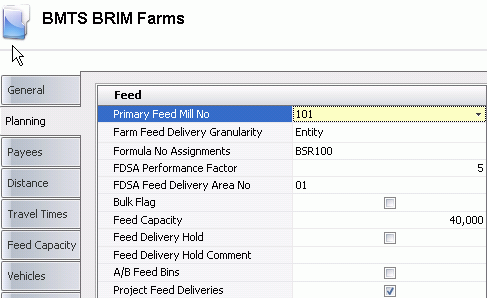
Primary Feed
Mill – establishes the primary feed mill that normally supplies
the farm. This will be used as the default feed mill.
Farm Feed
Delivery Granularity – determines which granularity level the
feed is delivered. The options available are Farm, Entity, House or
Pen.
Formula No
Assignments – indicates the default formula assignments for
entities placed at the farm. The assignment can be changed at placement
if required.
FDSA Performance
Factor – used to adjust the FDSA consumption projected for
the birds on the farm. If a value of '5' is entered, the consumption
will be increased by 5%. Alternatively, if a value of '-5' is entered,
the consumption will decrease by 5%.
FDSA Delivery
Area No – selects the feed delivery area that the farm is assigned
to. The delivery area is a user-defined field.
Bulk Flag
– selecting this option indicates that the feed is not stored in bulk
tanks.
Feed Capacity
– represents the total feed capacity for the farm. The capacity is
entered in lbs or kgs depending on the unit of measure used by the
division.
Feed Delivery
Hold – selecting this option will prevent feed deliveries from
being planned for the farm until the flag is removed.
Feed Delivery
Hold Comment – text field to enter the comments related to
the feed delivery hold.
A/B Feed Bins
– this option is selected if feed deliveries are alternatively made
to A and B bins at the farm.
Project Feed
Deliveries – this option determines if the farm is used in
FDSA to project deliveries.
Distance
The Distance tab is defined so that the feed mill can be optimized based
on proximity of processing plans. The distance and travel time fields
are to be completed. The distances and travel times are entered
for each feed mill that supplies the farm.

These values will be used for planning purposes. The distances are entered
in miles or kilometers depending on the unit of measurement for the division.
Feed Capacities
Seasonal feed capacity percentages can be entered by month to adjust
the projected amount of feed that can be delivered.
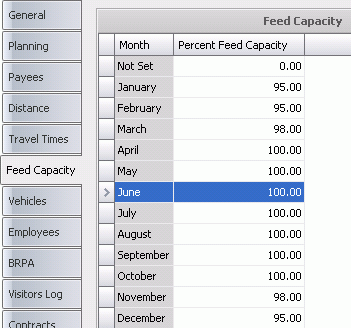
Houses
The only fields that need to be completed in Houses relate to the bin
capacities.
General
The bin capacities are defined on the General tab. The weight is entered
in lbs or kgs depending on the unit of measure defined for the division.
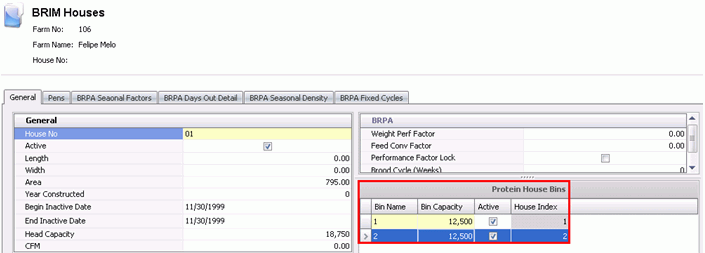
Feed
Formula Assignments
The Feed Formula Assignments determines the feed type and formulas that
are assigned to the product at placement. The Feed Formula Assignment
can be defined by entity or alternatively derived based on product, feed
mill and effective date. The Feed Formula Assignments care found in General>Master
Data>Feed Formula Assignments.

- Formula Assignment
No – alphanumeric field to identify the feed formula assignment
(maximum 20 characters).
- Formula Assignment
Name – description field for program (maimumx 50 characters).
- Feed Mill No
– assigns the formula assignment to the feed mill.
- Product No
– assigns the formula assignment to the product.
- Effective Date
– establishes the first date that the assignment becomes in effect.
- Feed Type No
– selects the feed type that is being assigned to the product. Feed
types are user-defined values.
- Formula
– filtered based on the Feed Type No, selects the feed formula for
the program
Optionally, the Feed Formula Assignment can be assigned at the entity
level. If the assignment is not defined on the entity, it will be derived
based on the entity product, feed mill and effective date of the assignment.

![]()








